| Article ID | Journal | Published Year | Pages | File Type |
|---|---|---|---|---|
| 8297251 | Biochemical and Biophysical Research Communications | 2014 | 6 Pages |
Abstract
Protein aggregation and its subsequent deposition in different tissues culminate in a diverse range of diseases collectively known as amyloidoses. Aggregation of hen or human lysozyme depends on certain conditions, namely acidic pH or the presence of additives. In the present study, the effects on the aggregation of hen egg-white lysozyme via incubation in concentrated solutions of three different chaotropic agents namely guanidine thiocyanate, guanidine hydrochloride and urea were investigated. Here we used three different methods for the detection of the aggregates, thioflavin T fluorescence, circular dichroism spectroscopy and atomic force microscopy. Our results showed that upon incubation with different concentrations (0.5, 1.0, 2.0, 3.0, 4.0, 5.0Â M) of the chemical denaturants, lysozyme was aggregated at low concentrations of guanidine thiocyanate (1.0 and 2.0Â M) and at high concentrations of guanidine hydrochloride (4 and 5Â M), although no fibril formation was detected. In the case of urea, no aggregation was observed at any concentration.
Related Topics
Life Sciences
Biochemistry, Genetics and Molecular Biology
Biochemistry
Authors
Saeed Emadi, Maliheh Behzadi,
